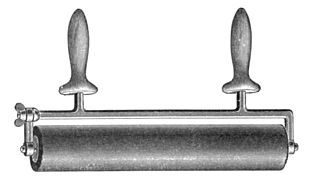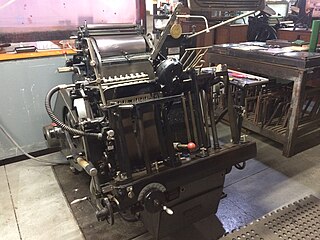 W
WLetterpress printing is a technique of relief printing. Using a printing press, the process allows many copies to be produced by repeated direct impression of an inked, raised surface against sheets or a continuous roll of paper. A worker composes and locks movable type into the "bed" or "chase" of a press, inks it, and presses paper against it to transfer the ink from the type, which creates an impression on the paper.
 W
WThe Albion press is a model of early iron hand printing press, originally designed and manufactured in London by Richard Whittaker Cope around 1820. It worked by a simple toggle action, unlike the complex lever-mechanism of the Columbian press and the Stanhope press. Albions continued to be manufactured, in a range of sizes, until the 1930s. They were used for commercial book-printing until the middle of the nineteenth century, and thereafter chiefly for proofing, jobbing work and by private presses. Francis Meynell often used an Albion to proof pages of his designs for Nonesuch Press books, and printed some small books and ephemera using the press. Printers still predominantly using an Albion Press in the United Kingdom to publish limited fine press editions include Ian Mortimer's I.M. Imprimit, and the St James Park Press of James Freemantle.
 W
WA brayer is a hand-tool used historically in printing and printmaking to break up and "rub out" (spread) ink before it was "beaten" using inking balls or composition rollers. The word is derived from the verb to "bray", meaning "to break, pound, or grind small, as in a mortar". A brayer consists of a short wooden cylinder with a handle fitted to one end; the other, flat end is used to rub the ink. In the late nineteenth century the term was applied in the United States to a small hand-roller, "used for spreading ink on the inking table, and for applying it to the distributing plates or rollers connected with presses". Such small rollers were sold as "brayers" from at least 1912 and later in the century the term was applied in the U.S. to hand-rollers of all sorts and sizes. It retains its original meaning in Europe.
 W
WA chase is a heavy steel frame used to hold type in a letterpress. Most of the space in the chase not occupied with type is filled with blocks of wood called furniture. The type and furniture are locked in place by quoins. When a chase is locked up with type, furniture, and quoins, it is called a forme.
 W
WIn letterpress printing and typesetting, a composing stick is a tray-like tool used to assemble pieces of metal type into words and lines, which are then transferred to a galley before being locked into a forme and printed. Many composing sticks have one adjustable end, allowing the length of the lines and consequent width of the page or column to be set, with spaces and quadrats of different sizes being used to make up the exact width. Early composing sticks often had a fixed measure, as did many used in setting type for newspapers, which were fixed to the width of a standard column, when newspapers were still composed by hand.
 W
WA composition roller is a tool used in letterpress printing to apply ink to a bed of type in a printing press. It consists of a cylinder made of a substance known as "roller composition" or simply "composition", a mixture of glue and sugar, with various additives such as glycerin depending on the particular recipe. Early recipes also included gypsum plaster and tar, though these were eventually found unnecessary.
 W
WIn typesetting, a forme is imposed by a stoneman working on a flat imposition stone when he assembles the loose components of a page into a locked arrangement, inside a chase, ready for printing.
 W
WAn ink ball, inking ball, or dabber was a tool used in printmaking and letterpress printing to apply ink to the plate or type to be printed.
 W
WA jobbing press, job press, or jobber is a variety of printing press used in letterpress printing.
 W
WThe Original Heidelberg Platen Press was a letterpress printing press manufactured by the Heidelberger Druckmaschinen company in Germany. It was often referred to as the "Windmill", after the shape and movement of its paper feed system. When introduced, it was also called the "Super Heidelberg" or the "Super Speed".
 W
WA quoin is a device used to lock printing type in a chase. Quoins are pairs of wedges, facing opposite directions. A wrench or quoin key forces them together.